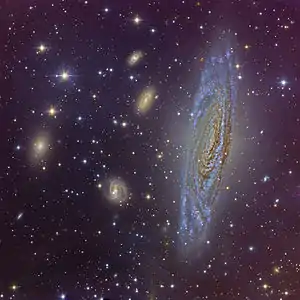NGC 7331
NGC 7331, also known as Caldwell 30, is an unbarred spiral galaxy about 40 million light-years (12 Mpc) away in the constellation Pegasus. It was discovered by William Herschel in 1784.[3] NGC 7331 is the brightest galaxy in the field of a visual grouping known as the NGC 7331 Group of galaxies. The other members of the group are the lenticular or unbarred spirals NGC 7335 and 7336, the barred spiral galaxy NGC 7337 and the elliptical galaxy NGC 7340. These galaxies lie far in the background at distances of approximately 332, 365, 348 and 294 million light years, respectively.[4]
| NGC 7331 | |
|---|---|
 Taken by Vicent Peris using the 3.5 meter telescope at the Calar Alto Observatory in southern Spain. | |
| Observation data (J2000 epoch) | |
| Constellation | Pegasus |
| Right ascension | 22h 37m 04.1s[1] |
| Declination | +34° 24′ 56″[1] |
| Redshift | 816 ± 1 km/s[1] |
| Distance | 39.8 ± 3.3 Mly (12.2 ± 1.0 Mpc) 40 ± 3 e6ly (12.2 ± 1.0 Mpc)[2] |
| Apparent magnitude (V) | 10.4[1] |
| Characteristics | |
| Type | SA(s)b[1] |
| Size | 120,000 ly (diameter) |
| Apparent size (V) | 10′.5 × 3′.7[1] |
| Other designations | |
| UGC 12113, PGC 69327,[1] Caldwell 30 | |
The galaxy is similar in size and structure to the Milky Way, and is sometimes referred to as "the Milky Way's twin".[5] However, discoveries in the 2000s regarding the structure of the Milky Way may call this similarity into doubt, particularly because the latter is now believed to be a barred spiral, compared to the unbarred status of NGC 7331.[6] In spiral galaxies the central bulge typically co-rotates with the disk but the bulge in the galaxy NGC 7331 is rotating in the opposite direction to the rest of the disk.[7] In both visible light and infrared photos of the NGC 7331, the core of the galaxy appears to be slightly off-center, with one side of the disk appearing to extend further away from the core than the opposite side.
Multiple supernova events have been observed in this galaxy. SN 1959D, a Type IIL supernova,[8] was the first supernova identified within NGC 7331.[1] The supernova was discovered by Milton Humason and H. S. Gates in a survey at Palomar Observatory.[9] More recent supernovae are SN 2013bu and SN 2014C, the latter of which underwent an unusual "metamorphosis" from a hydrogen-poor Type Ib to a hydrogen-rich Type IIn over the course of a year . [10] A 1903 photographic plate from Yerkes Observatory shows a magnitude 16.6 candidate transient that may have also been a supernova.[11]
Gallery
 Spiral galaxy NGC 7331, by HST.
Spiral galaxy NGC 7331, by HST. Galaxy NGC 7331 core, by HST.
Galaxy NGC 7331 core, by HST..jpg.webp) PIA21088 - Supernova SN 2014C (Optical and X-Ray)
PIA21088 - Supernova SN 2014C (Optical and X-Ray) NGC 7331 acquired with 17" PlaneWave CDK scope by W4SM in Louisa, VA
NGC 7331 acquired with 17" PlaneWave CDK scope by W4SM in Louisa, VA
 NGC 7331 seen by the 24 inch telescope at the Mount Lemmon Observatory
NGC 7331 seen by the 24 inch telescope at the Mount Lemmon Observatory NGC 7331 in ultraviolet by GALEX
NGC 7331 in ultraviolet by GALEX NGC 7331 (SDSS DR14)
NGC 7331 (SDSS DR14)
See also
References
- "NASA/IPAC Extragalactic Database". Results for NGC 7331. Retrieved 2006-11-10.
- Jensen, Joseph B.; Tonry, John L.; Barris, Brian J.; Thompson, Rodger I.; et al. (February 2003). "Measuring Distances and Probing the Unresolved Stellar Populations of Galaxies Using Infrared Surface Brightness Fluctuations". Astrophysical Journal. 583 (2): 712–726. arXiv:astro-ph/0210129. Bibcode:2003ApJ...583..712J. doi:10.1086/345430. S2CID 551714.
- The NGC/IC Project Archived 2011-02-28 at the Wayback Machine : NGC Discoverers List by Bob Erdmann.
- "Spiral Galaxy NGC 7331, Galaxy Group (NGC 7335, 7336, 7337)".
- "Seeing Double: Spitzer Captures Our Galaxy's Twin". Spitzer Space Telescope Newsroom. Spitzer Science Center. 2004-06-28. Archived from the original on May 17, 2007. Retrieved 2008-04-24.
- "The Milky Way Has Only Two Spiral Arms". 2008-06-03. Retrieved 2008-06-04.
- A Counter-rotating Bulge in the Sb Galaxy NGC 7331 , F. Prada, C. Gutierrez, R.F. Peletier, C.D. McKeith, the Astrophysical Journal, 463 :L9–L12, 20/5/1996
- "NASA/IPAC Extragalactic Database". Results for SN 1959D. Retrieved 2006-11-10.
- M. L. Humason; H. S. Gates (1960). "The 1959 Palomar Supernova Search". Publications of the Astronomical Society of the Pacific. 72 (426): 208–209. Bibcode:1960PASP...72..208H. doi:10.1086/127513.
- D. Milisavljevic; et al. (2015). "Metamorphosis of SN 2014C: Delayed Interaction Between a Hydrogen Poor Core-collapse Supernova and a Nearby Circumstellar Shell". The Astrophysical Journal. 815 (2): 120. arXiv:1511.01907. Bibcode:2015ApJ...815..120M. doi:10.1088/0004-637X/815/2/120. S2CID 31773513.
- Cerny; Chapman; Glusman; Kron; Liang (2021). "Precise Photometric Measurements from a 1903 Photographic Plate Using a Commercial Scanner". Publications of the Astronomical Society of the Pacific. arXiv:2101.03699.
- "Twins with differences". www.spacetelescope.org. Retrieved 29 January 2018.
External links
 Media related to NGC 7331 at Wikimedia Commons
Media related to NGC 7331 at Wikimedia Commons- Calar Alto Observatory – NGC 7331
- APOD (2004-07-01) – "A Galaxy So Inclined"
- SST – "Morphology of Our Galaxy's 'Twin'"
- NGC 7331 at the astro-photography site of Mr. T. Yoshida
- NGC7331 at W. Kloehr Astrophotography
- NGC 7331 on WikiSky: DSS2, SDSS, GALEX, IRAS, Hydrogen α, X-Ray, Astrophoto, Sky Map, Articles and images